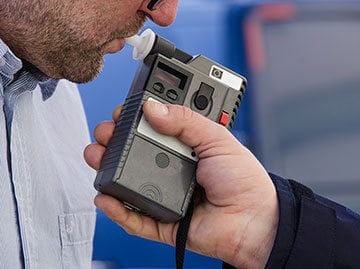Zero tolerance testing for alcohol.
Over the past several years we’ve written several articles on the subject of zero tolerance testing for alcohol. The point we’ve made in every article is that the best practice is to establish a cut-off level that will definitively identify a person who has been drinking, as opposed to regarding any result greater than .000 as a positive test for alcohol. Click to read one of these articles.
Today we want to discuss enforcement of a traffic law in Tennessee as a way to illustrate why it is a best practice to have a cut-off level for zero tolerance testing. Tennessee (as we assume many other states do as well), has a law that requires drivers to maintain control of their car within their lane. If the wheels of the car go outside the traffic lane – i.e., cross the center line or cross the inside fog line – the driver has violated the law. Law enforcement officers use this law as probable cause to stop a driver whom they suspect of drunk driving. Within the past year the cases of two individuals who were stopped for failure to maintain control of their vehicle within their lane appealed their cases to the Tennessee Supreme Court. In each case the police officer saw one instance of the wheels of the vehicle crossing the line. The issue before the court was does a single instance of crossing the line suggest that a driver is impaired and a violation of the law, and is therefore adequate cause for stopping a driver? The argument was that if an officer followed a motorist long enough they would likely eventually see an instance of the motorist crossing a line, and so allowing as adequate cause a single instance of failure to maintain control within the lane put every driver at risk of being stopped.
The parallel with zero tolerance alcohol testing is this: does a breath alcohol test result of .001 indicate that a driver has been drinking? Best practice for zero tolerance alcohol testing says no. We suggest a cut-off level of .01 for substance abuse programs and .02 for workplace testing.
And what did the Tennessee Supreme Court say about one instance of crossing the line? The court ruled that the way the law was written even one instance of crossing the line was a violation, and therefore was probable cause for stopping a driver. The court upheld the validity of the traffic stops for the two DUI cases.
Setting reasonable cut-off levels for alcohol testing allows one to be able to identify with a high degree of confidence an individual who has been drinking. With a cut-off level that is too low – i.e., any result other than .000 – individuals who have not been drinking may be identified as drinkers. This would be a false positive result – a “positive” result that was wrong. If one wasn’t concerned about false positives – in other words, if one wasn’t concerned that individuals might be wrongly identified as drinking and/or impaired – then low cut-off levels would be fine. But because the consequences of being identified as impaired can be significant, hardly anyone is willing to accept false positive results. Using the recommended cut-off levels for positive alcohol tests allows users a very high degree of confidence for positive test results.

